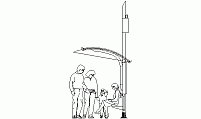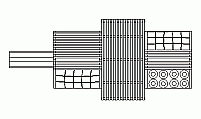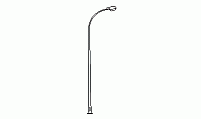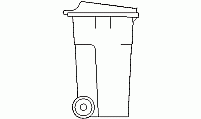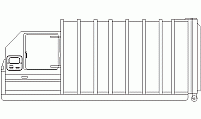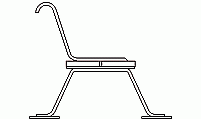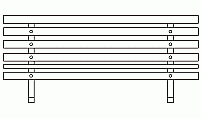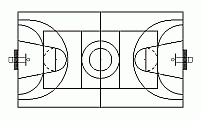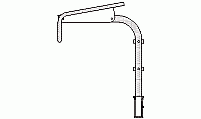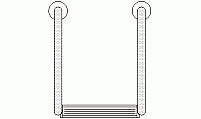CAD Blocks categories
 3D models
3D models home furniture
home furniture sanitary ware - bathrooms
sanitary ware - bathrooms professional equipment
professional equipment doors and windows
doors and windows people and animals
people and animals plants and trees
plants and trees vehicles - transports
vehicles - transports architectural details
architectural details mechanical - electrical
mechanical - electrical urban planning - civil works
urban planning - civil works safety health construction
safety health construction accessible design
accessible design drawing sheet
drawing sheet signals
signals construction machinery
construction machinery accessories and objects
accessories and objects maps and street maps
maps and street maps
Elegant Multi-Head Street Light for CAD Designs

size: 6 kb
category: street furniture
related categories:
description: CAD block showcasing a three-headed street light in a traditional style, viewed from the top. The central head features a larger mounting plate for stability, while the lateral arms connect two symmetrical heads with decorative bases.
file extension: .dwg CAD - AutoCAD software
Discover Detailed Multi-Head Street Light CAD Blocks
Detailed Structure of the Multi-Head Street Light
The multi-head street light consists of three lighting heads arranged symmetrically. The central head is mounted on a reinforced square plate, secured with bolts for stability. Horizontal arms extend outward to hold the two lateral heads, ensuring durability and balance. Each head features a pyramid-shaped casing designed for optimal light distribution, with the arms crafted for structural integrity and visual appeal.
Alternative configurations for multi-head street lights include designs with varying numbers of heads or distinct mounting methods. These can range from intricate traditional styles to minimalistic modern designs, adapting to a wide variety of architectural settings and lighting requirements.
Standard Dimensions of Multi-Head Street Lights
Typical dimensions for multi-head street lights in architectural plans include pole heights of 120 inches (3.05 meters), with horizontal arms extending 24 inches (0.61 meters) on either side. The central mounting plate is usually 12 inches (0.3 meters) wide to provide sufficient stability for the lighting structure.
Construction and Integration Techniques
- What materials are typically used?
- Multi-head street lights are generally constructed using galvanized steel, cast iron, or aluminum. These materials are chosen for their high resistance to environmental factors such as rust, corrosion, and extreme weather conditions. Galvanized steel offers durability and a long lifespan, making it a popular choice. Aluminum is lightweight and equally resistant to rust, which simplifies installation. Cast iron is less common today due to its weight, but it provides a timeless, decorative aesthetic for traditional designs.
- How are these lights installed?
- Installation involves securing the light pole to a concrete base using anchor bolts. The concrete base is often pre-measured and poured to match the pole's dimensions. Anchor bolts are embedded in the concrete and aligned with the mounting holes on the pole's base plate. Once secured, lateral arms are attached, and lighting heads are mounted. This step-by-step process ensures the structure remains stable even under harsh conditions such as strong winds, making it a reliable option for public spaces.
- Can they integrate with solar power?
- Yes, multi-head street lights are increasingly designed to integrate with solar power systems. Solar panels can be installed on top of the pole or nearby to capture sunlight during the day. Energy is stored in rechargeable batteries, which power the lights at night. This setup reduces dependency on the electrical grid, cutting down on energy costs and promoting sustainability. Solar integration is particularly useful in remote or off-grid areas where traditional power supply infrastructure may not be readily available.
- What types of light sources are suitable?
- The most common light sources include LEDs, high-intensity discharge (HID) lamps, and fluorescent bulbs. LEDs are preferred for their energy efficiency, longer lifespan, and minimal maintenance requirements. HID lamps, which include metal halide and sodium vapor options, are known for their high brightness and are ideal for illuminating large areas. Fluorescent bulbs, though less efficient than LEDs, still offer a cost-effective alternative for some applications. The choice depends on the specific lighting needs of the project.
- How can they complement urban designs?
- Multi-head street lights enhance urban spaces by combining aesthetics and functionality. They can be tailored to suit traditional or modern architectural themes, making them versatile for various settings. In historical areas, they can feature ornate designs that match the surrounding architecture, while in contemporary spaces, minimalist designs provide a clean and sleek appearance. By improving visibility and contributing to the overall visual harmony, these lights play a vital role in creating safe and attractive urban environments.
Advantages of Multi-Head Street Lights
Multi-head street lights provide extensive illumination, making them ideal for public spaces such as parks, plazas, and boulevards. Their symmetrical design ensures even light distribution, enhancing safety and visibility for pedestrians and vehicles. Additionally, their versatile aesthetic can adapt to both classic and modern architectural themes.
Compared to single-head designs, these lights offer enhanced coverage and improved durability. Their ability to integrate with energy-efficient systems, such as solar panels, makes them environmentally friendly and cost-effective over time, further increasing their appeal for large-scale projects.
History and Evolution of Street Lighting
Street lighting has evolved significantly, from the early use of oil and gas lamps to modern electric and solar-powered systems. Multi-head designs emerged to address the need for wider and more uniform illumination, particularly in public spaces where safety and aesthetics are priorities.
Globally, variations in multi-head street lights reflect regional architectural styles. While some designs emphasize ornate and traditional elements, others adopt sleek and modern aesthetics. This evolution highlights the adaptability of these lights to meet diverse urban planning needs.



